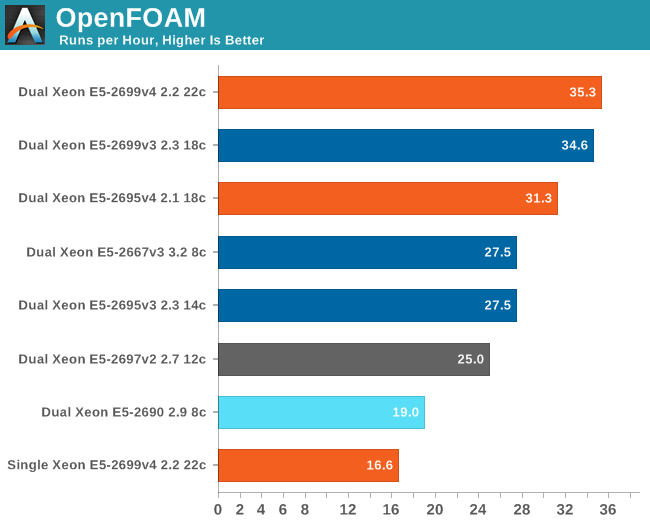The Intel Xeon E5 v4 Review: Testing Broadwell-EP With Demanding Server Workloads
by Johan De Gelas on March 31, 2016 12:30 PM EST- Posted in
- CPUs
- Intel
- Xeon
- Enterprise
- Enterprise CPUs
- Broadwell
HPC: Fluid Dynamics with OpenFOAM
Computational Fluid Dynamics is a very important part of the HPC world. Several readers told us that we should look into OpenFOAM, and my lab was able to work with the professionals of Actiflow. Actiflow specializes in combining aerodynamics and product design. Calculating aerodynamics involves the use of CFD software, and Actiflow uses OpenFOAM to accomplish this. To give you an idea what these skilled engineers can do, they worked with Ferrari to improve the underbody airflow of the Ferrari 599 and increase its downforce.
We were allowed to use one of their test cases as a benchmark, however we are not allowed to discuss the specific solver. All tests were done on OpenFOAM 2.2.1 and openmpi-1.6.3. The reason why we still run with OpenFOAM 2.2.1 is that our current test case does not work well with higher versions.
We also found AVX code inside OpenFoam 2.2.1, so we assume that this is one of the cases where AVX improves FP performance.

As this is AVX code, the clock speed of our Xeon processors can be lower than Intel's official specifications, and turbo boost speeds are also lower. Despite the fact that on Broadwell the only cores that reduce their clock when running AVX code are the AVX-active cores themseves (the others can continue at higher speeds), OpenFOAM does not run appreciably faster on the top of the line Xeon E5 v4 than it did on the E5 v3.
It is not as if OpenFOAM does not scale: 22% more cores delivers 13% higher performance (E5-2699v4 vs E5-2695v4). No, our first impression is that the new Xeon v4 needs to lower the clockspeed more than the old one. The official specifications tell us that both the Xeon E5-2699 v4 and v3 should run AVX code at up to 2.6 GHz with all cores enabled. The reality is however that Broadwell runs at a lower clock on average.










112 Comments
View All Comments
Kevin G - Thursday, March 31, 2016 - link
Much like how Apple skipped Haswell-EP, they also skipped a generation of cards from AMD and nVidia. So even if Apple doesn't wait for new GPUs, their is certainly an update on the GPU side.The more interesting possibility would be if Apple were to go with Xeon D in the Mac Pro instead of Broadwell-EP. Apple would need a big PLX chip considering the number of lanes they's want to use but it is possible.
bill.rookard - Thursday, March 31, 2016 - link
Another issue is that they're not under any pressure from any competition to really innovate. I don't even remember the last time I read anything about Opteron servers... let alone something about any NEW Opterons.ComputerGuy2006 - Thursday, March 31, 2016 - link
A sign of things to come for Broadwell-e?Seems like a tricky situation. Because skylake-e will come with a new platform in 2017, while broadwell-e isn't the fastest IPC and there are crazy rumors it will might cost $1500 (lol Intel). We also have Zen later this year that might give good performance with good cost/perf ratio.
extide - Thursday, March 31, 2016 - link
Yeah so Intel only gives us the LCC part for the -E platform, so we will see the 10-core SKU as the top, It will either be $1000, or $1500 ... so yeah not sure how that will end up. Although there will be 8 and 6 core options that should be pretty affordable.Hopefully they do an 8 core part with 28 lanes for under $500, as THAT would be a great deal!
dragonsqrrl - Sunday, April 3, 2016 - link
I'm hoping the 8 core SKU is around $600, the position the x930K traditionally occupies. What makes me a little worried is that there will be 4 SKUs instead of 3 this time (one 10 core, one 8 core, and two 6 core), and I'm not sure there's enough room under the $600 price point for two 6 core processors.jasonelmore - Thursday, March 31, 2016 - link
Can it run Star Citizen?theduckofdeath - Thursday, March 31, 2016 - link
A question we'll never get an answer to? :DJohanAnandtech - Friday, April 1, 2016 - link
It probably runs mostly on Xeons. Well, the back end that is :-)extide - Thursday, March 31, 2016 - link
BOOM, 454mm^2 on the worlds best process. The "other" 14/16nm processes use bigger geometry than Intel's 14nm process.Now we just need those other guys to catch up so we can see 450+mm GPU's!
Kevin G - Thursday, March 31, 2016 - link
Intel still has plenty of room to increase die size. The largest chip they've produced was the Tukwila Itanium 2 at 699 mm^2. Granted that was a 65 nm design but Haswell-EX is a juggarnaught at 662 mm^2 on Intel's more recent 22 nm process. Seems reasonable that SkyLake-EX could go to 32 cores as Intel has >200 mm^2 of rectal limit left.As for GPU's, they're also huge. nVidia's GM200 is 601 mm^2 and AMD's Fiji is 'only' 596 mm^2 both on 28 nm process. TSMC's 20 nm process was skipped so even using the looser 16 nm FinFET, GPU's will see a significant shrink compared to the those high end chips.